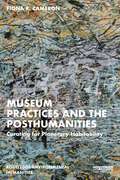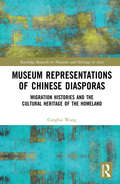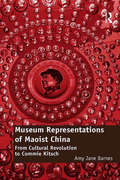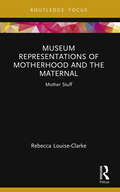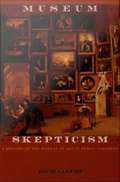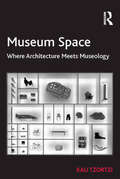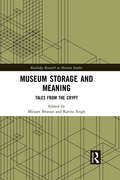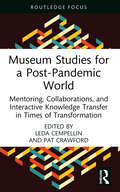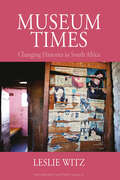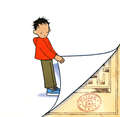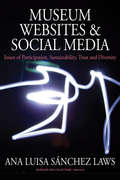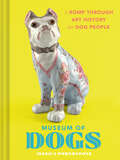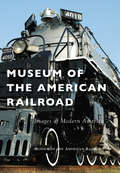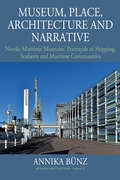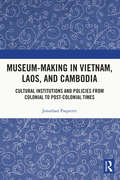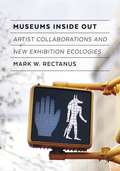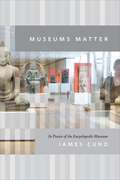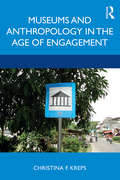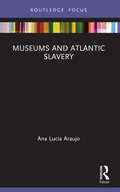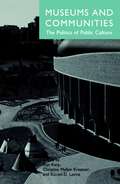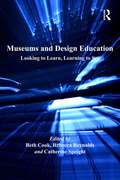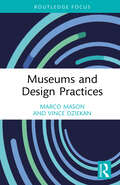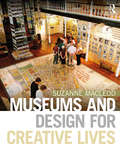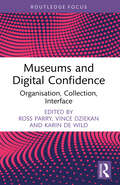- Table View
- List View
Museum Practices and the Posthumanities: Curating for Planetary Habitability (Routledge Environmental Humanities)
by Fiona R. CameronThis book critiques modern museologies and curatorial practices that have been complicit in emerging existential crises. It confidently presents novel, more-than-human curatorial visions, methods, frameworks, policies, and museologies radically refiguring the epistemological foundations of curatorial, museological thinking, and practice for a habitable planet. Modern curatorial and museological practices are dominated by modern humanism in which capital growth, social, technological advancement, hubris, extraction, speciest logics, and colonial domination predominate, often without reflection. While history, science, and technology museums and their engagement with non-human worlds have always been ecological as an empirical reality, the human-centred frameworks and forms of human agency that institutions deploy tend to be non-cognizant of this reality. Museum Practices and the Posthumanities: Curating for Planetary Habitability reveals how these practices are ill-equipped to deal with the contemporary world of rapid digital transformations, post-Covid living, climate change, and its impacts among other societal changes, and it shows how museums might best meet these challenges by thinking with and in more-than-human worlds. This book is aimed at museological scholars and museum professionals, and it will provide them with the inspiration to conduct research on and curate from a different ecological reference point to promote a world good enough for all things to thrive in radical co-existence.
Museum Representations of Chinese Diasporas: Migration Histories and the Cultural Heritage of the Homeland (Routledge Research on Museums and Heritage in Asia)
by Cangbai WangMuseum Representations of Chinese Diasporas is the first book to analyse the recent upsurge in museums on Chinese diasporas in China. Examining heritage-making beyond the nation state, the book provides a much-needed, critical examination of China’s engagement with its diasporic communities. Drawing on fieldwork in more than ten museums, as well as interviews with museum practitioners and archival study, Wang offers a timely analysis of the complex ways in which Chinese diasporas are represented in the museum space of China, the ancestral homeland. Arguing that diasporic heritage is highly ambivalent and introducing a diasporic perspective to the study of cultural heritage, this book opens up a new avenue of inquiry into the study and management of cultural heritage in China and beyond. Most importantly, perhaps, Wang sheds new light on the dynamic between China and Chinese diasporas through the lens of the museum. Museum Representations of Chinese Diasporas takes a transnational perspective that will draw attention to the under-researched connections between heritage, mobility and meaning in a global context. As such, this cross-disciplinary work will be of interest to scholars and students working in the museum and heritage studies fields, as well as those studying Asia, China, migration and diaspora, anthropology, history and culture.
Museum Representations of Maoist China: From Cultural Revolution to Commie Kitsch
by Amy Jane BarnesThe collection, interpretation and display of art from the People’s Republic of China, and particularly the art of the Cultural Revolution, have been problematic for museums. These objects challenge our perception of ’Chineseness’ and their style, content and the means of their production question accepted notions of how we perceive art. This book links art history, museology and visual culture studies to examine how museums have attempted to reveal, discuss and resolve some of these issues. Amy Jane Barnes addresses a series of related issues associated with collection and display: how museums deal with difficult and controversial subjects; the role they play in mediating between the object and the audience; the role of the Other in the creation of Self and national identities; the nature, role and function of art in society; the museum as image-maker; the impact of communism (and Maoism) on the cultural history of the twentieth-century; and the appropriation of communist visual iconography. This book will be of interest to researchers and students of museology, visual and cultural studies as well as scholars of Chinese and revolutionary art.
Museum Representations of Motherhood and the Maternal: Mother Stuff (Museums in Focus)
by Rebecca Louise-ClarkeMuseum Representations of Motherhood and the Maternal is the first book to address the underrepresentation of motherhood in museums. Questioning how mothering and maternal experiences should be represented in museums, Louise-Clarke argues that such institutions wield the power to influence what we think about families, mothers and the labour of care. Using the term ‘mothering’ to encompass lived experiences of mothering or caring that are not exclusively tied to sex, gender, or the maternal body, Louise-Clarke explores the ways that experiences of mothering can be represented in museums. The book begins this exploration with Australia’s Museums Victoria (MV), then expands to look at international cases. Offering a blueprint for what Louise-Clarke calls a ‘museology of mothering’, the book imagines what a museum that articulates maternal subjectivities might look and sound like. Museum Representations of Motherhood and the Maternal initiates a dialogue between museum studies and maternal studies, making it essential reading for scholars and students working in both disciplines. Questioning conventional museum practices and the values that underpin them, the book will also be of interest to museum and heritage practitioners around the world.
Museum Skepticism: A History of the Display of Art in Public Galleries
by David CarrierIn Museum Skepticism, art historian David Carrier traces the birth, evolution, and decline of the public art museum as an institution meant to spark democratic debate and discussion. Carrier contends that since the inception of the public art museum during the French Revolution, its development has depended on growth: on the expansion of collections, particularly to include works representing non-European cultures, and on the proliferation of art museums around the globe. Arguing that this expansionist project has peaked, he asserts that art museums must now find new ways of making high art relevant to contemporary lives. Ideas and inspiration may be found, he suggests, in mass entertainment such as popular music and movies. Carrier illuminates the public role of art museums by describing the ways they influence how art is seen: through their architecture, their collections, the narratives they offer museum visitors. He insists that an understanding of the art museum must take into account the roles of collectors, curators, and museum architects. Toward that end, he offers a series of case studies, showing how particular museums and their collections evolved. Among those who figure prominently are Baron Dominique Vivant Denon, the first director of the Louvre; Bernard Berenson, whose connoisseurship helped Isabella Stewart Gardner found her museum in Boston; Ernest Fenollosa, who assembled much of the Asian art collection now in the Museum of Fine Arts, Boston; Albert Barnes, the distinguished collector of modernist painting; and Richard Meier, architect of the J. Paul Getty Center in Los Angeles. Carrier's learned consideration of what the art museum is and has been provides the basis for understanding the radical transformation of its public role now under way.
Museum Space: Where Architecture Meets Museology
by Kali TzortziMuseums are among the iconic buildings of the twenty-first century, as remarkable for their architectural diversity as for the variety of collections they display. But how does the architecture of museums affect our experience as visitors? This book proposes that by seeing space as common ground between architecture and museology, and so between the museum building and its display, we can illuminate the individuality of each museum and the distinctive experience it offers - for example, how some museums create a sense of personal exploration, while others are more intensely didactic, and how the visit in some cases is transformed into a spatial experience and in other cases into a more social event. The book starts with an overview of the history of museum buildings and display strategies, and a discussion of theoretical and critical approaches. It then focuses on specific museums as in-depth case studies, and uses methods of spatial analysis to look at the key design choices available to architects and curators, and their effects on visitors’ behaviour. Theoretically grounded, methodologically original, and richly illustrated, this book will equip students, researchers and professionals in the fields of architecture, museum studies, curating, exhibition design, and cultural studies, with a guide for studying museums and a theoretical framework for their interpretation.
Museum Storage and Meaning: Tales from the Crypt (Routledge Research in Museum Studies)
by Mirjam Brusius Kavita SinghBeyond their often beautiful exhibition halls, many museums contain vast, hidden spaces in which objects may be stored, conserved, or processed. Museums can also include unseen archives, study rooms, and libraries which are inaccessible to the public. This collection of essays focuses on this domain, an area that has hitherto received little attention. Divided into four sections, the book critically examines the physical space of museum storage areas, the fluctuating historical fortunes of exhibits, the growing phenomenon of publicly visible storage, and the politics of objects deemed worthy of collection but unsuitable for display. In doing so, it explores issues including the relationship between storage and canonization, the politics of collecting, the use of museum storage as a form of censorship, the architectural character of storage space, and the economic and epistemic value of museum objects. Essay contributions come from a broad combination of museum directors, curators, archaeologists, historians, and other academics.
Museum Studies for a Post-Pandemic World: Mentoring, Collaborations, and Interactive Knowledge Transfer in Times of Transformation
by Leda Cempellin and Pat CrawfordMuseum Studies for a Post-Pandemic World demonstrates that digital literacy, creativity, and resilience, as the COVID-19 pandemic has so vividly illustrated, are now vital components of the classroom and of the curator’s toolbox.Museum studies students are increasingly asked to engage with new team dynamics and collaborative models, often relocated to the virtual world. Authored by academics, cultural heritage partners, students, and alumni, the chapters in this volume move beyond a consideration of the impact of digitisation to envision new strategies and pedagogies for fuller, more sustainable approaches to cultural literacy, exhibition, and visitor engagement. International case studies present models of collaborative practices between teams of diverse sizes and professional backgrounds. The volume demonstrates that the COVID-19 pandemic has forced the use of a variety of pedagogically and culturally significant hybrid and virtual models that provide innovative learning modalities to meet the needs of future generations of digital native patrons. This book offers meaningful strategies that will help academic and cultural heritage institutions engaged in museum studies to survive — and even thrive — in the face of future disasters by expanding programme accessibility beyond the physical confines of their buildings.Museum Studies for a Post-Pandemic World will be of interest to students and researchers engaged in the study of museums, the arts, cultural management, and education. It should also be of interest to museum practitioners around the world.
Museum Times: Changing Histories in South Africa (Museums and Collections #16)
by Leslie WitzMuseums flourished in post-apartheid South Africa. In older museums, there were renovations on the go, and at least fifty new museums opened. Most sought to depict violence and suffering under apartheid and the growth of resistance. These unlikely journeys are tracked as museums became a primary setting for contesting histories. From the renowned Robben Island Museum to the almost unknown Lwandle Migrant Labour Museum, the author demonstrates how an institution concerned with the conservation of the past is simultaneously a site for changing history.
Museum Trip
by Barbara LehmanMuseums: filled with mysterious, magical art and curiosities? Or secrets? And what might happen if a boy suddenly became part of one of the mind-bending exhibits? Join the fun in Museum Trip, by Barbara Lehman, the author-illustrator of the Caldecott Honor-winning The Red Book.
Museum Trip
by Barbara LehmanMuseums: filled with mysterious, magical art and curiosities? Or secrets? And what might happen if a boy suddenly became part of one of the mind-bending exhibits? Join the fun in Museum Trip, by Barbara Lehman, the author-illustrator of the Caldecott Honor–winning The Red Book.
Museum Websites and Social Media: Issues of Participation, Sustainability, Trust and Diversity (Museums and Collections #8)
by Ana Sánchez LawsOnline activities present a unique challenge for museums as they harness the potential of digital technology for sustainable development, trust building, and representations of diversity. This volume offers a holistic picture of museum online activities that can serve as a starting point for cross-disciplinary discussion. It is a resource for museum staff, students, designers, and researchers working at the intersection of cultural institutions and digital technologies. The aim is to provide insight into the issues behind designing and implementing web pages and social media to serve the broadest range of museum stakeholders.
Museum of Dogs: A Romp through Art History for Dog People
by Jessica PoundstoneJourney into your own pocket-sized museum, filled with a collection of charming art-historical pups! Ready to meet a pack of very good dogs immortalized in painting and sculpture? This quirky and fascinating little book collects the best canines in art history, including:Rustic figurines carved in ancient GreeceElegant porcelain pooches handcrafted in 19th-century RussiaA tiny Japanese netsuke in the shape of a puppyA portrait of a spaniel woven by a beadwork artisan in MexicoAnd so much more!Artist and writer Jessica Poundstone has scoured the world's museum collections for these hidden treasures and offers fun and informative commentary on each. Her bite-sized text gives historical context and celebrates each dog’s sweet, noble, or wacky personality, which transcends history to hit us right in the feels. This delightful volume offers pure delight for dog lovers and art lovers alike.PERFECTLY GIFTABLE: This is a charming gift for people who love art and dogs! A petite and beautifully designed hardcover book, it makes an entertaining and educational present for friends and family or a treat for yourself. It's simply impawsible to resist.CURATED COLLECTION: Flipping through this art book is like getting a special guided tour of a wondrous museum devoted entirely to our furry friends. In a world of sensory overload, it offers a wonderful way to tap into the joy of something curated just for you. FUN ANGLE ON FINE ART: Whether you are a devoted museumgoer or casually art-curious, this book offers a unique and delightful spin on art history. The content covers a wide range of styles, media, and eras, creating a perfect opportunity to brush up on your art IQ with the help of man's best friend.Perfect for:Animal loversArt and art history buffsGift-giving to dog owners, artists, and collectorsFans of art/humor crossovers like Men to Avoid in Art and Life and William Wegman: Being HumanFans of clever art history like Art Dog and A History of Art in 21 Cats
Museum of the American Railroad (Images of Modern America)
by Museum of the American RailroadEstablishing its collection as the Age of Steam exhibit at Dallas's Fair Park in 1963, the Museum of the American Railroad would go on to acquire over 45 locomotives and railcars. By 2006, the museum needed to move from its first home to a larger facility to allow more space to exhibit the collection of railcars, documents, and other artifacts. One of the keystone pieces is the GG-1 electric locomotive that pulled Robert Kennedy's funeral train in 1968. It has been restored to its original Pennsylvania Railroad appearance. The museum also houses the Centennial--the world's largest diesel-electric locomotive--as well as the rare and famous Santa Fe Alco PA-1 locomotive, acquired from the Smithsonian Institution.
Museum, Place, Architecture and Narrative: Nordic Maritime Museums’ Portrayals of Shipping, Seafarers and Maritime Communities (Museums and Collections #15)
by Annika BünzA characteristic trait of the maritime museums is that they are often located in a contemporary and/or historical environment from which the collections and narratives originate. The museum can thereby be directly linked to the site and its history. It is therefore vital to investigate the maritime museums in terms of relationships between landscape, architecture, museum and collections. This volume unravels the kinds of worlds and realities the Nordic maritime museums stage, which identities and national myths they depict, and how they make use of both the surrounding maritime environments and the architectural properties of the museum buildings.
Museum-Making in Vietnam, Laos, and Cambodia: Cultural Institutions and Policies from Colonial to Post-Colonial Times
by Jonathan PaquetteBuilding on archival work undertaken in France and fieldwork undertaken in Southeast Asia, Museum-Making in Vietnam, Laos, and Cambodia provides a critical analysis of museum histories and development in three former colonial territories. This work documents the development of museums in French Indochina (1862-1954), specifically Vietnam, Laos, and Cambodia. The book explores the colonial culture of exhibition, traces the growth of museum collections through archaeological missions to Indochina and other parts of Asia, and examines the role of museums in the cultural life of this colonial society. In particular, the author re-contextualizes the role and part played by colonial museums in the implementation of heritage policies during the colonial era in French Indochina, a dimension that is often overlooked. Additionally, the book addresses the effects that the Second World War, the Vichy Regime, and the Japanese occupation had on these cultural institutions. The transformation of these museums in post-independence Vietnam, Laos, and Cambodia is also discussed. Providing comparisons with other colonial and post-colonial experiences, Museum-Making in Vietnam, Laos, and Cambodia will be a valuable resource for researchers in museum and heritage studies. It will also appeal to researchers and graduate students engaged in the study of history, anthropology, sociology, political science, and development and international studies.
Museums Inside Out: Artist Collaborations and New Exhibition Ecologies
by Mark W. RectanusAn ambitious study of what it means to be a museum in the twenty-first century In Museums Inside Out, Mark W. Rectanus investigates how museums are blurring the boundaries between their gallery walls and public spaces. He examines how artists are challenging and changing museums, taking readers deep into new experiments in exhibition making. Along the way, Rectanus offers insights about how museums currently exemplify the fusion of the creative and digital economies. Exploring contemporary museum practices, initiatives, and collaborations, Rectanus analyzes projects like the Collective Museum, which foster land-based museum ecologies by co-curating with local communities. The Schirn Kunsthalle, Petach Tikva Museum of Art, and Tate Modern reflect museums as cultural zones for performance, inside and outside the museum. In addition, he studies a joint project between the Van Gogh Museum and the investment firm Deloitte Luxembourg, extracting insights on the transfer of expertise from museums to the financial sector. Wide-ranging in its case studies, and boldly putting museum studies and art into conversation, Museums Inside Out delivers vital insights into the ideas and places that museums are creating in contemporary culture.
Museums Matter: In Praise of the Encyclopedic Museum (The Rice University Campbell Lectures)
by James CunoThe concept of an encyclopedic museum was born of the Enlightenment, a manifestation of society’s growing belief that the spread of knowledge and the promotion of intellectual inquiry were crucial to human development and the future of a rational society. But in recent years, museums have been under attack, with critics arguing that they are little more than relics and promoters of imperialism. Could it be that the encyclopedic museum has outlived its usefulness? With Museums Matter, James Cuno, president and director of the Art Institute of Chicago, replies with a resounding “No!” He takes us on a brief tour of the modern museum, from the creation of the British Museum—the archetypal encyclopedic collection—to the present, when major museums host millions of visitors annually and play a major role in the cultural lives of their cities. Along the way, Cuno acknowledges the legitimate questions about the role of museums in nation-building and imperialism, but he argues strenuously that even a truly national museum like the Louvre can’t help but open visitors’ eyes and minds to the wide diversity of world cultures and the stunning art that is our common heritage. Engaging with thinkers such as Edward Said and Martha Nussbaum, and drawing on examples from the politics of India to the destruction of the Bramiyan Buddhas to the history of trade and travel, Cuno makes a case for the encyclopedic museum as a truly cosmopolitan institution, promoting tolerance, understanding, and a shared sense of history—values that are essential in our ever more globalized age. Powerful, passionate, and to the point, Museums Matter is the product of a lifetime of working in and thinking about museums; no museumgoer should miss it.
Museums and Anthropology in the Age of Engagement
by Christina KrepsMuseums and Anthropology in the Age of Engagement considers changes that have been taking place in museum anthropology as it has been responding to pressures to be more socially relevant, useful, and accountable to diverse communities. Based on the author’s own research and applied work over the past 30 years, the book gives examples of the wide-ranging work being carried out today in museum anthropology as both an academic, scholarly field and variety of applied, public anthropology. While it examines major trends that characterize our current "age of engagement," the book also critically examines the public role of museums and anthropology in colonial and postcolonial contexts, namely in the US, the Netherlands, and Indonesia. Throughout the book, Kreps questions what purposes and interests museums and anthropology serve in these different times and places. Museums and Anthropology in the Age of Engagement is a valuable resource for readers interested in an historical and comparative study of museums and anthropology, and the forms engagement has taken. It should be especially useful to students and instructors looking for a text that provides in one volume a history of museum anthropology and methods for doing critical, reflexive museum ethnography and collaborative work.
Museums and Atlantic Slavery (Museums in Focus)
by Ana Lucia AraujoMuseums and Atlantic Slavery explores how slavery, the Atlantic slave trade, and enslaved people are represented through words, visual images, artifacts, and audiovisual materials in museums in Europe and the Americas. Divided into four chapters, the book addresses four recurrent themes: wealth and luxury; victimhood and victimization; resistance and rebellion; and resilience and achievement. Considering the roles of various social actors who have contributed to the introduction of slavery in the museum in the last thirty years, the analysis draws on selected exhibitions, and institutions entirely dedicated to slavery, as well as national, community, plantation, and house museums in the United States, England, France, and Brazil. Engaging with literature from a range of disciplines, including history, anthropology, sociology, art history, tourism and museum studies, Araujo provides an overview of a topic that has not yet been adequately discussed and analysed within the museum studies field. Museums and Atlantic Slavery encourages scholars, students, and museum professionals to critically engage with representations of slavery in museums. The book will help readers to recognize how depictions of human bondage in museums and exhibitions often fail to challenge racism and white supremacy inherited from the period of slavery.
Museums and Communities: The Politics of Public Culture
by Ivan Karp Steven Levine Christine Mullen KreamerContributors to this volume examine and illustrate struggles and collaborations among museums, festivals, tourism, and historic preservation projects and the communities they represent and serve. Essays include the role of museums in civil society, the history of African-American collections, and experiments with museum-community dialogue about the design of a multicultural society.
Museums and Design Education: Looking to Learn, Learning to See
by Rebecca ReynoldsHow can museum educators and higher education tutors enhance the way HE students use museums? There are many examples in the UK of museums and universities working together in productive and innovative ways, but these relationships tend to be based on individual enthusiasm and opportunistic arrangements. Despite the growing importance of museum education departments, higher education tends to be overlooked by museums. This book looks at the interaction between design students and museums, and explores issues, projects and emerging ideas about how museums can better support HE students. It illustrates the general lessons that can be learnt, both strategic and practical, which can help to bring about long-term and constructive relationships between museums and universities in order to enable effective student learning.
Museums and Design Practices (Critical Perspectives on Museums and Digital Technology)
by Vince Dziekan Marco MasonMuseums and Design Practices explores the increasingly critical role that design is playing in museums by focusing on how human-centred design approaches are being embraced and incorporated into their work practices.This book advances “design-as-practice” as a way to acknowledge the technosocial dimension of the working culture of cultural organisations. It reveals how designing is a situated phenomenon that enables museums and galleries to respond in a digitally mature way to emerging contexts and challenges of digital transformation. The original thesis forwarded by the authors is reinforced by reflections shared by leading museum practitioners and designers on the complex and multifaceted nature of human-centred practices found in museums and the various ways they function within their organisational working cultures. The infusion of design into all levels of museum practice demonstrates the capacity to transform how museums approach visitor experience, inclusive collaboration, and knowledge sharing in order to build resilience in the face of change and respond to the ‘wicked problems’ confronting cultural organisations today.Museums and Design Practices is for students and researchers as well as museum practitioners – especially those keen to understand emerging relationships that are forming between digital technology, design and the cultural work of museums. It will also be of interest to researchers and students working in the fields of design, digital culture, and museum studies.
Museums and Design for Creative Lives
by Suzanne MacLeodMuseums and Design for Creative Lives questions what we sacrifice when we allow economic imperatives to shape public museums, whilst also considering the implications of these new museum realities. It also asks: how might we instead design for creative lives? Drawing together 28 case studies of museum design spanning 70 years, the book explores the spatial and social forms that comprise these successful examples, as well as the design methodologies through which they were produced. Re-activating a well-trodden history of progressive museum design and raising awareness of the involvement of the built forms in how we feel, think and act, MacLeod provides strategies and methods to actively counter the economisation of museums and a call to museum makers to work beyond the economic and advance this deeply human history of museum making. Museums and Design for Creative Lives will be of great interest to academics and students in museum studies, gallery studies, heritage studies, arts management, communication and architecture and design departments, as well as those interested in understanding more about design as a resource in museums. The book provides a valuable resource for museum leaders and practitioners.
Museums and Digital Confidence: Organisation, Collection, Interface (Critical Perspectives on Museums and Digital Technology)
by Ross Parry Vince Dziekan Karin De WildMuseums and Digital Confidence explores the evolving nature of digital practices in museums. It interrogates the skills, literacies, and mindsets that can support the use of digital technologies within these institutions. It also reflects on why digital adoption has faltered (at times), why digital continues to matter, and how the digital museum may flourish into the future.Underscored by national and international research, this edited volume brings together leading experts from museology, museum management and curation, organisational studies, and cultural policy to outline a new framing of museum digital confidence. It does so by offering a series of critically engaged perspectives derived from a range of practices that reveal how museums have managed to successfully re-orient themselves in order to not only face but also embrace the ongoing challenges presented by the highly interconnected, media-pervasive, and technologised world to which contemporary museums must continually adapt. This book presents a set of ‘framings’ to help museums clarify how they can work purposefully, productively, and sustainably with digital at an organisational level, in terms of managing collections, and through curating public-facing exhibitions and programmes.Museums and Digital Confidence shares insights that will be essential reading for students, researchers, and museum practitioners who are interested in better understanding – and acting upon – the digital transformation of museums.
